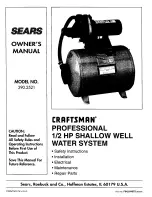
11
Troubleshooting
Note
- Correct external fuel
leaks immediately! These
conditions will result in reduced
engine performance such as:
hard starting, stalling, reduced
power, and other associated
problems.
New filter installations
must be filled with fuel
and fuel system must be
adequately primed following
the
engine manufacturer’s
recommendations
, if applicable.
Existing installation difficulties
are usually associated with
improper priming procedures
or damage to the unit or fuel
system. The result is either
internal air suction or external
fuel leakage. Diagnosis should
be in these following steps:
1. Check fuel tank level and
make sure any fuel delivery
valves are in open position,
as applicable.
2. Ensure T-handle, bowl
fasteners, and fuel fittings are
tight. Also verify that bowl
drain is closed.
3. If filter is new, check potential
restriction at fuel tank draw
tube. An in-tank strainer may
be plugged.
Correct Application
- It is very
important that filter is not ‘under
specified’ for the application.
The maximum fuel flow rating of
filter must not be exceeded and
engine manufactures maximum
fuel inlet restriction, must not be
exceeded. Doing so will reduce
efficiency and de-gas (pull air
from) fuel.
Filter
- Replacement filters
are available in 2, 10, and 30
micron ratings. Filtration needs
are based on application, fuel
quality, maintenance schedules,
and operating climates. A simple
rule to remember is - the finer
the filtration, the more frequent
the filter change. Always carry
extra replacement filters with
your equipment as one tankful
of excessively contaminated fuel
can plug a filter. When clogged
to the maximum capacity, filters
will have a brown to black color
or tar like contaminants may
be present - this is normal.
An appearance of a multi-
colored slime (which may have
a foul odor) is an indication of
microbiological contamination.
This condition must be treated
immediately.
Severe conditions must be
corrected by a repair facility.
Note
- Never operate Racor
unit without the filter in place -
the 'filter safety valve' will not
expose outlet hole on fuel return
tube if filter is removed and fuel
will not flow to engine. Instead,
punch emergency tab on the
top of filter and leave in place.
Puncturing
emergency
tab will
bypass all filtration and send
unfiltered fuel to your engine.
Service filter as soon as possible
to avoid harmful contaminants
flowing downstream to the final
filter or engine.
Water Sensors
- This feature
alerts operator of a high-water
condition. The bowl is then
drained of water at earliest
convenience. Note - a Racor
water detection module is
needed to work with the in-bowl
sensor. The unit should activate
when water reaches sensor
tips (and when they measure
between 47,000 and 100,000
ohms of resistance, depending
on detection module used.) If
not, tips may be fouled with a
coating. Remove water sensor
and clean tips with a cloth. Run
a jumper wire between tips
with ignition ON to test system.
Difficulties usually lie in the wire
connections, power source, or
an independent ground.
Heaters
- In-filter heaters are
starting aids, but may be left
on during cold operations to
continue to supply heat. The
325 watt heater is an extremely
reliable option, but MUST be
powered via a relay switch due
to initial amperage surge at
start-up: 27 amps at 12 vdc and
13 amps at 24 vdc. They do not
activate unless the fuel is below
50°F (10°C) and automatically
deactivate at 80°F (28°C).
Heater Testing
- Heaters
can only be tested when the
thermostat is closed (fuel
temperature is below 50°F
or 10°C). With a ampmeter
attached to external wiring, and
engine off, amperage should
increase when heater is switched
on.
All Racor FH filter assemblies
are 100% tested to ensure a
leak-proof, quality product.
Note
- Correct external fuel
leaks immediately! In the event
difficulties are experienced with
your filter assembly or a problem
appears to prevent the engine
from running smoothly, refer to
the procedures on the previous
page. Note - Apply Parker Super
O-lube (part number RK 31605)
or equivalent to all seals at major
attachment points to maintain
integrity, seal elasticity, to fill
small voids, and to provide
protection from degradation.
Perform all checks with engine
OFF (and applicable valves
closed). For replacement parts,
refer to the Replacement Parts
section of this manual.






























